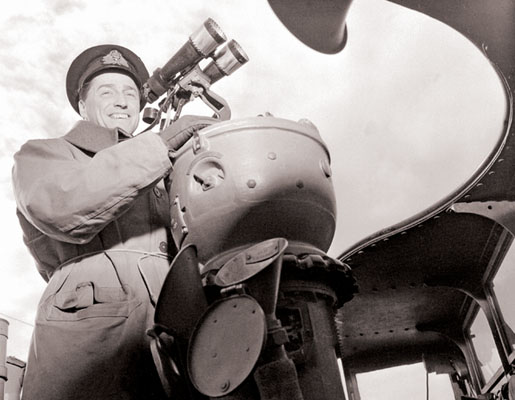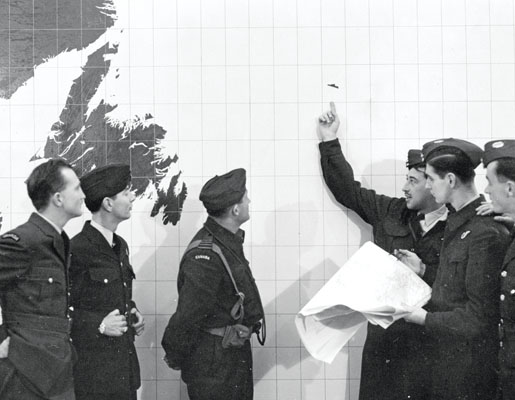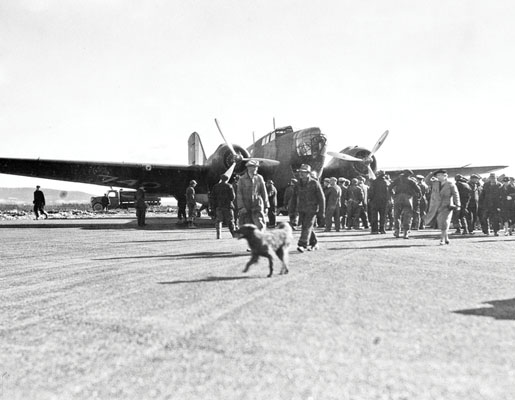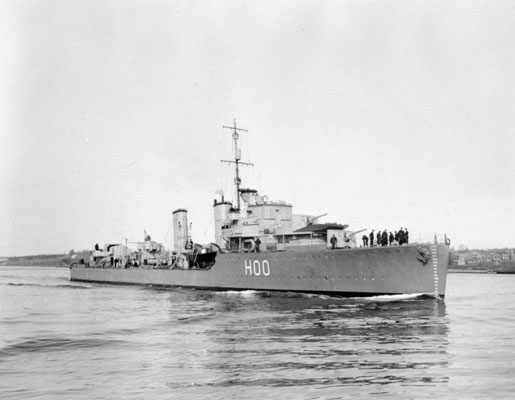For a British-bound fleet and its under-equipped escort,
early November 1942 brought pure carnage

Lieutenant-Commander Desmond Piers stands on the bridge of HMCS Restigouche in April 1944. [LIEUT. JOHN DANIEL MAHONEY/DND/LAC/PA-136286]
September and October 1942 were frustrating months for Germany’s mid-Atlantic U-boats. German Admiral Karl Dönitz’s staff attributed this to three factors: fair weather that made attacking difficult; a large number of novice U-boat captains commanding their first cruises; and the power of Allied radar.
That said, German intelligence was good and Dönitz was determined to inflict heavy losses on the Allies. He knew that transatlantic convoys passed through a narrow corridor south of Newfoundland, so in late October he moved a 13-submarine wolf pack named Veilchen (violet) well inshore northeast of St. John’s to intercept eastbound convoys early in their passage.
The plan worked because almost perpetual fog on the Grand Banks allowed the Germans to operate with near impunity within range of Newfoundland-based aircraft. It also allowed Dönitz to deploy Veilchen just 640 kilometres from RCAF bases at Torbay and Botwood. Given the prevailing westerly winds, this was close to the “prudent limit of endurance” for Newfoundland-based Catalinas and Hudsons—although in theory they should have operated effectively to almost 1,000 kilometres. The RCAF nonetheless made a concerted effort to attack the U-boat concentration despite the brutal flying conditions.
U-522 was south of Newfoundland headed for the Gulf of St. Lawrence on Oct. 30 when it reported SC-107. Kapitänleutnant Herbert Schneider was ordered to shadow the convoy, and he would dog SC-107 into the mid-ocean for the next seven days. Allied intelligence plotted Schneider’s contact report and alerted the escort. A warning of a second U-boat—U-520—in the convoy’s path about 80 kilometres east of St. John’s was passed later in the day.
By the time Escort Group C-4, under RCN Lieutenant-Commander Desmond “Debbie” W. Piers, joined SC-107 at 7 p.m. on Oct. 30, U-520 was in contact too. Piers’ group was down to one destroyer, his own HMCS Restigouche. The rest of C-4 was typical for the period: three Canadian corvettes (HMC ships Amherst, Arvida and Sherbrooke) and one British corvette (HMS Celandine). HMCS Algoma and later HMCS Moose Jaw joined for passage to the U.K. en route to the Operation Torch landings in French North Africa in November. Apart from the high-frequency radio direction-finding (HF/DF) set on Restigouche, which Piers had scrounged in Londonderry during the summer, the group’s Canadian ships lacked modern equipment, and only Celandine carried Type 271 10-cm radar. Fortunately, the rescue ship Stockport carried HF/DF, so Piers had two sets and could get accurate fixes on U-boat radio transmissions. Piers was so junior he was actually paid less than his ship’s doctor, but he had been at sea since 1939 and had yet to lose a ship.
If Allied intelligence knew the true nature of wolf pack Veilchen, there is no evidence they revealed it to Piers. Eleven of the 15 U-boats deployed to attack SC-107 were commanded by seasoned veterans. (U-520 and U-522 were additional to Veilchen’s 13 subs.) “SC-107 would have to fight its way through, rather than around, an exceptionally strong and well-prepared force,” the RCN official history observed.

Flying Officer E.L. Robinson of RCAF No. 145 Squadron points to the location where he and his crew sank the German submarine U-658 on Oct. 30, 1942. [DND/LAC/PA-501325]
It says a great deal about the operational conditions for convoy protection in the northwest Atlantic to note that the battle for SC-107 peaked even before it entered the midocean air gap. The RCAF did what it could to help. On Oct. 30, a Hudson of No. 145 Squadron sank U-658 on SC-107’s assigned track northeast of St. John’s, and attacked U-521. Later that day, a Douglas Digby of No. 10 Squadron sank U-520 east of St. John’s. Unfortunately, Schneider in U-522 remained in contact.
By noon on Nov. 1, SC-107 was less than 185 kilometres southwest of Veilchen, which was stretched across the convoy’s path like a huge drift net. Over the next 24 hours, the HF/DF operators of Restigouche and Stockport intercepted and plotted 25 U-boat transmissions. By triangulating the intercepts, Piers used Restigouche to put a number of U-boats down, but one destroyer was not enough to drive off all of them. SC-107 struck Veilchen square in the middle, and the wings of the patrol line collapsed inward toward the convoy. By dusk, five U-boats were in contact and more were on the way.
What happened over the following night was carnage, as two veteran U-boat captains, Schneider in U-522 and Siegfried von Forstner in U-402, made several passes through the convoy. Piers deployed his meagre escort well, but Arvida’s 1.5-metre Canadian radar set failed, as did Celandine’s Type 271 set. So the escort was virtually blind and offered little challenge to experienced U-boat commanders.
Von Forstner struck first, at 10:55 p.m., hitting Empire Sunrise of the ninth column on the port side. Piers responded with Operation Raspberry, a night illumination tactic that forced U-402 to dive. Restigouche briefly gained contact astern of SC-107 and dropped a few charges before returning to the convoy.

A Digby aircraft is the first plane to land at Torbay on Oct. 18, 1941. [DND/LAC/PA-136271]
The pyrotechnics around SC-107 brought U-381 to the scene by 3:05 a.m. on Nov. 2. It immediately fired three torpedoes at Restigouche, narrowly missing the destroyer. Five minutes later, von Forstner—again inside the screen—hit two ships in the port column. While C-4 searched the port side of SC-107 for U-402, Schneider in U-522 penetrated the starboard side of the convoy and hit SS Hartington. In the confusion, von Forstner returned to SC-107 only to be driven off. At about 4 a.m., U-84 found the derelict Empire Sunrise astern of SC-107 and sank her.
The night was not yet done. At 6:40 a.m., purely by chance, von Forstner and Schneider attacked simultaneously. Von Forstner’s U-402 torpedoed two ships on the port side, while Schneider’s torpedoes hit two on the starboard side. Operation Raspberry led to a counter attack on Schneider, but only dawn—which arrived about an hour later—brought relief to SC-107. Eight ships had been lost in one night of furious action. Among the U-boats, only U-437 suffered enough damage to force it back to France.
Bad weather, fog and the mayhem of the previous night nearly ended the battle on Nov. 2. Attempts by RCAF aircraft, now operating at the limit of their range and in dreadful weather, were entirely futile. Although SC-107 was barely 640 kilometres from Newfoundland, it had effectively entered the air gap.
Dönitz might have given up the chase on Nov. 2, but the battle for SC-107 was not over. In fact, the real midocean battleground lay ahead. Moreover, German intelligence intercepted and decoded the convoy’s routing signal on that day. So Veilchen was ordered to pursue. Through the day, U-boats probed the fog trying to get a fix on SC-107. The ether was filled with their transmissions as they passed information gleaned from glimpses through the murk, from their own sonar sets, from their Metox radar detectors (which could locate the RCN’s 1.5-metre sets) and from the tactical communications of the escort itself. One sub, U-438, narrowly avoided being run over by the convoy. Piers could plot the U-boat radio traffic, but with only one destroyer and no modern radar, there was little he could do. When Celandine was sent off to investigate an HF/DF report, she lost the convoy for 24 hours.
But U-522 clung tenaciously to SC-107. Schneider even managed a successful daylight submerged attack that day, adding a ninth ship to the list of losses. Moose Jaw arrived to help, and then Veilchen briefly lost contact, just as the destroyer HMS Vanessa arrived from nearby HX-213.
The next day, when visibility improved, nine U-boats regained contact. Lieutenant Louis Audette, commanding officer of the corvette Amherst, climbed the mast of his ship to direct fire on von Forstner’s U-402, and drove him off. Meanwhile, Vanessa and Celandine chased U-boats located by HF/DF, damaging four. Amid of all this, U-521 penetrated from the starboard side and hit one ship; Arvida tracked and attacked the sub to no avail. Von Forstner, too, got inside the convoy that day. Approaching SC-107 ahead on the surface, U-402 was forced to dive by Restigouche. When von Forstner finally put up his periscope, he was between the convoy’s third and fourth columns. The periscope brought down a hail of gunfire from every ship nearby and von Forstner was forced to abandon any plans to launch torpedoes. Stockport picked up survivors from the stricken SS Hihira.

HMCS Restigouche sails into Halifax in 1940. [DND/LAC/PA-104199]
The battle continued through the night of Nov. 3-4. SC-107 tried to shake off the shadowers by making an emergency turn just after dusk, but that simply brought it into the path of U-89 and U-132. U-89 attacked at 8:49 p.m. and hit the convoy commodore’s ship, SS Jeypore. Pursuit of U-89 by the escort opened up the convoy to U-132, which hit three ships at close range at 11:40 p.m. Two of these, SS Hatimura and Hobbema, were loaded with munitions. The result was perhaps the largest pre-nuclear explosion ever. The blast lifted Arvida’s stern out of the water, damaged Algoma’s engines and led the bridge watch of Restigouche to report in that they had been torpedoed. The steamer Titus was struck so hard by the blast that her crew simply abandoned ship. Louis Audette in Amherst remembered the event as an explosion of monumental proportions. U-132 was never heard from again.
Subsequent attempts by Veilchen to attack SC-107 failed, and dawn on Nov. 4 brought some relief. Stockport (now with more than 300 survivors aboard, a record unsurpassed during the entire war), an escort oiler and two corvettes were detached to Iceland. Two U.S. Navy tugs assumed rescue duty. Six U-boats remained in contact that night, but only Korvettenkapitän Dietrich Lohmann in U-89 braved the deteriorating weather and the weakened escort. Just after dusk, he torpedoed the SS Daleby, the last ship lost. On Nov. 5, Restigouche provided an HF/DF bearing to an RAF Liberator, which attacked and seriously damaged U-89. The aircraft supported SC-107 for most of the day, and three USN escorts arrived to help. By Nov. 10, SC-107 was safe in British waters.
The battle for SC-107 lasted seven days, covering more than 1,600 kilometres of ocean. Fifteen U-boats pursued the convoy, sinking 15 ships. Commodore Howard E. Reid, Flag Officer, Newfoundland, commented in the aftermath that SC-107 was “one of the most disastrous convoys we have ever had.” He was not the only one to notice.
In early December, the British asked the Canadian government to remove its escorts from the mid-ocean until they could be retrained. The RCN protested that a lack of modern equipment was the real problem. While the issue was under review, the Canadian-escorted slow convoy ONS-154 lost 14 ships in another disastrous passage.
In early January 1943, Canada agreed to the British request. The RCN’s reward for a year of selfless dedication to the cause was to be blamed for recent high losses and to be banished from its premier operational role on the eve of the crisis of the Atlantic war.
Advertisement





















